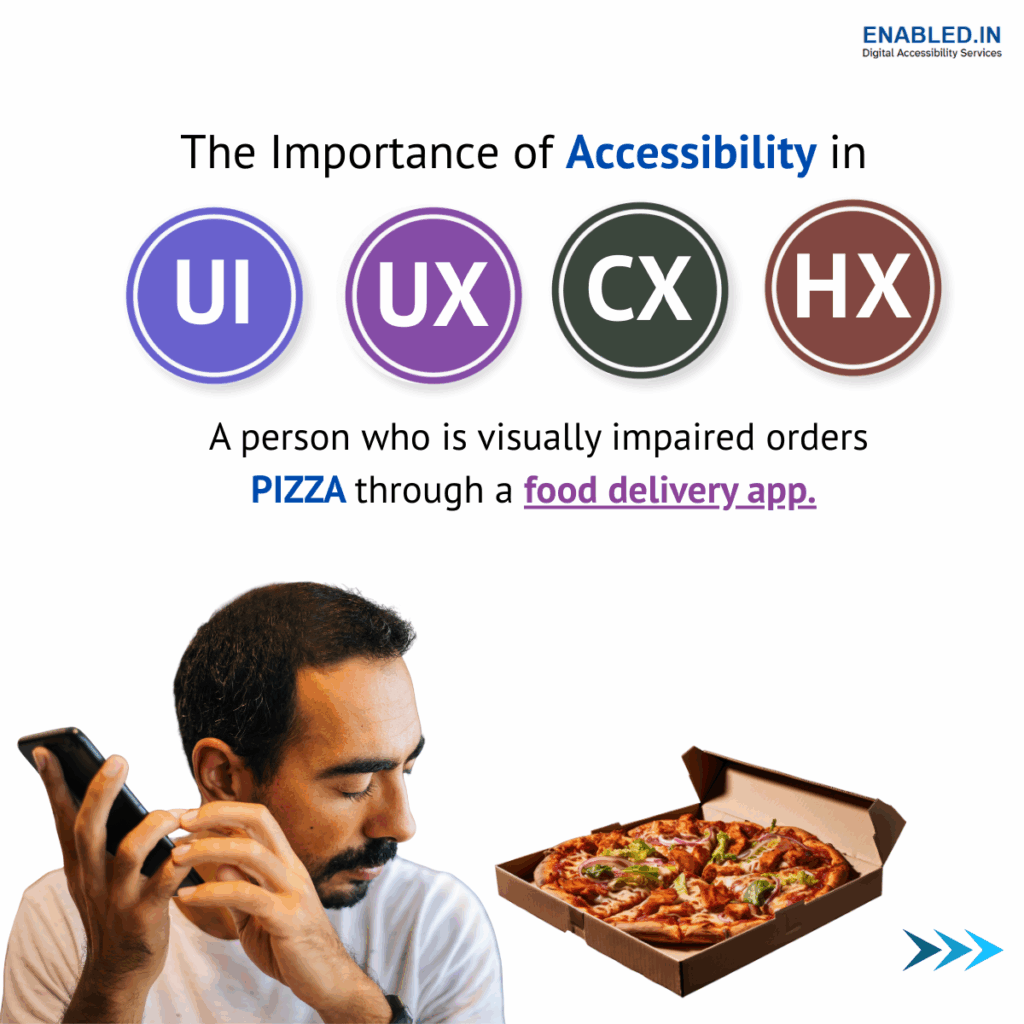Accessibility UI UX CX HX – In today’s digital world, designing products that are not only usable but truly inclusive is no longer optional, it’s essential.
Accessibility should span beyond permanent disabilities to also consider temporary and situational limitations, ensuring every user feels empowered, respected, and included.
Let’s explore how the layers of design UI, UX, CX, and HX work together to create meaningful experiences for all.

UI – User Interface: The Interface Users Engage With
The UI is the visible and interactive layer of any digital product. It includes buttons, menus, layouts, and visual elements.
- Goal: Make interfaces perceivable, operable, and understandable.
- Accessibility Considerations:
- Permanent disabilities: Screen-reader-friendly labels, high-contrast colors, large touch targets.
- Temporary disabilities: Adjustable font size, voice input for one-handed use (e.g., temporary injury).
- Situational disabilities: Glare-free mode, large buttons for quick access in bright sunlight or noisy environments.
Example: A visually impaired user can navigate a food delivery app because the “Add to Cart” button is properly labeled for screen readers and has sufficient touch space.
2. UX – User Experience: How It Feels to Interact
UX goes beyond visuals, it’s about how smooth, intuitive, and satisfying the interaction feels.
- Goal: Ensure users can complete tasks efficiently and independently.
- Accessibility Considerations:
- Permanent disabilities: Step-by-step voice navigation, logical flow compatible with assistive technology.
- Temporary disabilities: Simplified flows for one-handed use or limited mobility.
- Situational disabilities: Quick and simple workflows for noisy, crowded, or bright environments.
Example: A visually impaired person orders pizza easily because the app provides audio instructions for each step and auto-fills saved delivery addresses.
3. CX – Customer Experience: The Entire Brand Journey
CX encompasses the end-to-end relationship a customer has with a brand, including all touchpoints like digital, physical, and human interactions.
- Goal: Build trust, loyalty, and emotional connection.
- Accessibility Considerations:
- Permanent disabilities: Accessible notifications, inclusive support, respectful communication.
- Temporary disabilities: Flexible delivery options, reminders, alternative interaction modes.
- Situational disabilities: Multi-channel notifications (SMS, voice, email), offline options.
Example: Notifications about pizza delivery are accessible via audio, SMS, or email, and support staff are trained to interact inclusively with users with different abilities.
4. HX – Human Experience: Designing for Life
HX is the broadest perspective, focusing on how digital products impact human life, society, and well-being. It considers emotional, cognitive, and social aspects of experiences.
- Goal: Empower all humans, enhance dignity, reduce stress, and make interactions meaningful.
- Accessibility Considerations:
- Permanent disabilities: Promote independence and social participation.
- Temporary disabilities: Enable autonomy even during short-term limitations.
- Situational disabilities: Reduce frustration in challenging contexts like noise, bright light, or multitasking.
Example: A user with a temporary injury can order food independently, or a visually impaired user enjoys the freedom of navigating the app confidently both feel respected and empowered.
Inclusive Accessibility Across All Layers
Accessibility is not just a checkbox for UI, it flows through UX, CX, and HX, creating a truly human-centered design. Here’s a summarized view:
| Layer | Humanized Focus | Permanent Disabilities | Temporary Disabilities | Situational Disabilities |
|---|---|---|---|---|
| UI | Friendly and intuitive | Screen-reader labels, high contrast, large touch targets | Adjustable font size, one-handed input | Glare-free mode, large buttons |
| UX | Supportive and guiding | Voice navigation, logical flow | Simplified flows, one-handed gestures | Quick, simple workflows |
| CX | Caring and trustworthy | Accessible notifications, inclusive support | Flexible delivery, reminders | Multi-channel communication, offline options |
| HX | Empowering and joyful | Independence, dignity, inclusion | Autonomy, confidence | Seamless usability, stress reduction |
Humanized Story Example
Imagine David, a visually impaired user, ordering pizza:
- UI: Buttons are clearly labeled and readable by his screen reader.
- UX: Voice instructions guide him step-by-step through the menu and checkout.
- CX: Delivery notifications are accessible and support staff communicates inclusively.
- HX: Ravi feels independent, confident, and included the technology empowers him rather than frustrates him.
Even someone with a temporary injury or dealing with a situational challenge like bright sunlight or carrying a baby can enjoy the same seamless experience, because the product is designed for humans, not just “typical users.”
Accessibility isn’t just a technical feature,
it’s human-centered design that makes
people feel respected, empowered, and included.
Accessibility is not just a requirement
it’s good business.
Make your product inclusive,
WCAG, ADA & EAA compliant, and future-ready.
Sathasivam Kannupayan
Email : sathasivam@enabled.in
Phone : +91 98 40 51 56 47